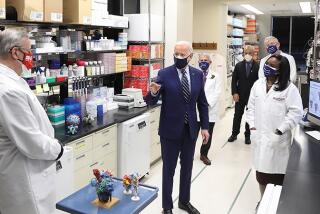Techniclone’s Temporary President Made Permanent
- Share via
The run-up in biotechnology stocks during the first three months this year saved tiny Techniclone Corp. from the brink of oblivion. Shares that were trading at 25 cents in December hit $16.63 in March.
But as Techniclone stock has since plummeted--along with a general drop in biotech stocks--the future is a bit more complicated for the Tustin developer of cancer treatments.
John Bonfiglio, though, isn’t letting the market hamper him too much as he continues to downsize and refocus the company. Bonfiglio, brought in as interim president in a shake-up last fall, was named Tuesday as the company’s full-time president and chief executive.
“We’re going to have to ride the ups and downs of the market,” he said Tuesday after the company’s stock lost 3 cents in trading to close at $2.53 a share on Nasdaq.
Bonfiglio figures that the best way to improve shareholder value is to show investors that the company’s products are real.
“The big payoff is getting a commercial product out there, and that’s what we’re striving to do,” he said.
With Bonfiglio on board, the company’s strategy has changed, said Edward Legere, a Techniclone director and the company’s largest shareholder. “He’s done quite a good job in helping turn this thing around,” Legere said.
In the past, Techniclone focused too much on wanting to become a manufacturer of antibodies--akin to smart biological missiles--to seek cancer cells and destroy them.
Now the company is focusing on getting those therapies, primarily four that target different types of cancers, through clinical trials and government approvals as commercial products.
Even though the anti-cancer therapies are in early-phase trials, Bonfiglio hopes that the promise of a concrete product in the pipeline will keep the stock price up.
The company has drawn down $12 million of its $20-million equity line of credit to fund its operations, and can continue to draw against it as long as shares remain above $1.
As the company gets closer to creating a product, Bonfiglio said, it may then seek a round of private funding or perhaps even a secondary offering. “We want to burn money in things that will make us successful,” he said.
More to Read
Inside the business of entertainment
The Wide Shot brings you news, analysis and insights on everything from streaming wars to production — and what it all means for the future.
You may occasionally receive promotional content from the Los Angeles Times.










